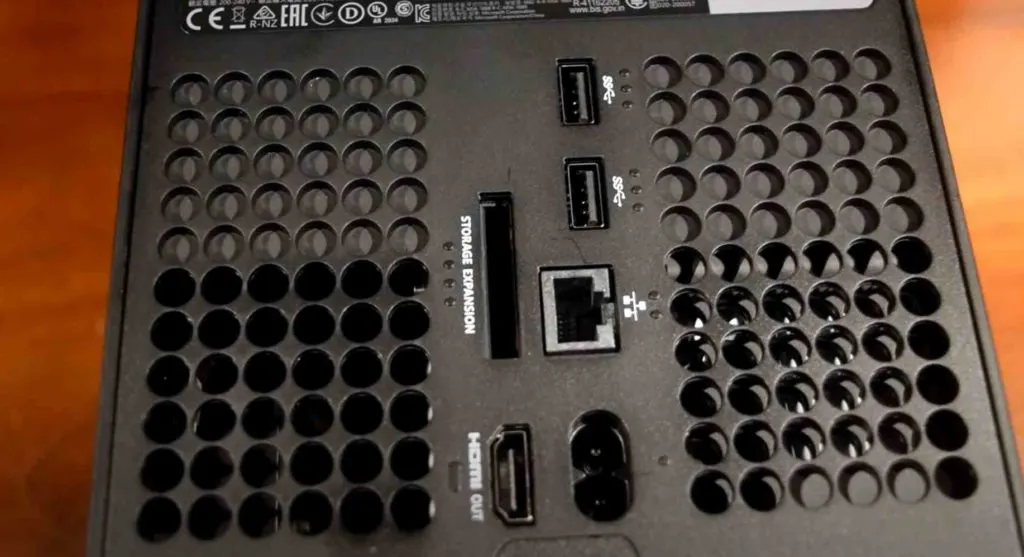The Xbox Series X and the Xbox Series S do not have Wi-Fi 6. While this is disappointing, it actually makes surprisingly little difference in most situations. Wi-Fi 6 is not really about achieving higher speeds for a single device but is more about handling lots and lots of devices in a small area. This means that for the average gamer playing their Xbox Series X or Xbox Series S from home, Wi-Fi 6 is not that beneficial.
Xbox Series X | S WiFi 6 Support
What are the Xbox Series X | S WiFi Specs
The Xbox Series X and Xbox Series S both utilize Wi-Fi 5 technology. They support both the 2.4 GHz and 5 GHz Wi-Fi bands. When I tested my Xbox WiFi performance, I found that Real-world speeds in excess of 200 Mbps are possible using the Wi-Fi built into both the Series X and Series S consoles.
This is more than enough for most people, especially given that according to Ookla’s Speedtest.net, the average broadband connection is 135 Mbps in the United States and 85 Mbps globally. The Wi-Fi 5 technology built into the Xbox Series X and Xbox Series S consoles is more than fast enough to keep pace. It is also important to note that Microsoft is only recommending a minimum of 5 Mbps for optimal results. Of course, having faster download speeds will make for faster downloads of games and updates.

The Xbox Series X and Xbox Series S also both include a gigabit ethernet port. This allows for a wired connection of up to about 945 Mbps. This is faster than any real-world speeds seen with Wi-Fi 6. It also provides a much more stable connection with lower latency. Latency is a top priority when it comes to online gaming, and a wired connection is always preferable when latency is paramount.

About Wi-Fi 6
Wi-Fi 6 is the latest generation of Wi-Fi technology. It was originally named 802.11ax but was renamed when the Wi-Fi Alliance changed the naming scheme used to reference each generation of Wi-Fi technology. The new naming scheme is meant to be easier to understand as it follows a sequential pattern, with each new release getting a higher number.
The primary focus of Wi-Fi 6 is providing faster Wi-Fi in high-density environments. Examples of high-density environments include sports stadiums, university auditoriums, casinos, event centers, and theaters. In these types of environments, Wi-Fi 6 is better optimized to provide stable performance than previous Wi-Fi generations.
There are still some benefits to Wi-Fi 6 that apply to a home environment, particularly in dense urban neighborhoods. The increased efficiency of Wi-Fi 6 allows for higher bandwidth. This is beneficial, especially if you have an internet connection faster than about 400 Mbps. For slower internet connections, the difference will be less noticeable.
The official Wi-Fi 6 specification arrived in late 2019, and Wi-Fi 6 enabled hardware was first released in 2020. With the change also came a change in the naming convention used by the Wi-Fi Alliance. This has simplified the terminology for the average user. Instead of 802.11ax, we have Wi-Fi 6. The previous generation has also been renamed to be called Wi-Fi 5 instead of 802.11ac.
As of 2023, WiFi 6E has been released and is an improved version of WiFi 6. It also allows for the use of the new 6 GHz WiFi band for even faster speeds and less interference.
What Makes Wi-Fi 6 Faster
There are two important technologies that make Wi-Fi 6 connections much faster than Wi-Fi 5, MU-MIMO, and OFDMA.
MU-MIMO stands for “multi-user, multiple input, multiple output,” it is technically supported by some newer Wi-Fi 5 devices, but it is improved with Wi-Fi 6. MU-MIMO technology allows an access point to send and receive data from multiple devices at the same time. Without this technology, devices have to wait their turn to send and receive data.
Right now, MU-MIMO allows access points to communicate with four devices at a time. Wi-Fi 6 allows access points to communicate with up to eight. This is part of the reason it performs much better than previous generations when used in high-density environments.
The other new technology, which is even more important, is OFDMA. OFDMA stands for “orthogonal frequency division multiple access.” The primary function is to allow one transmission to deliver data to multiple devices at once.

Rks 1910
Tuesday 31st of October 2023
What you said is no true . WiFi 6 is much faster than 5 can't compare pal . I have virgin at home one gig speed WiFi 6 router and its ultra fast downloading compare to WiFi 5 was use before upgrade virgin 500 mbs but only 5g. You need good device WiFi 6 to see the difference. But it's worth defo . WiFi 6 is much faster download and better signal . My device ( s 22 ultra ) ( acer Rog ) WiFi 6. I have aswell other standard device what are not support WiFi 6 like acer e3 or ps5 xbox . Result ps5 max speed download 300 mbs when acer go easy to 970 mbs when download 100 gb game.
Zachary Harper
Wednesday 20th of December 2023
WiFi 6 can offer higher speeds than WiFi 5. However most of the improvements that WiFi 6 brought forward were aimed at capacity and improvements in dense WiFi environments.